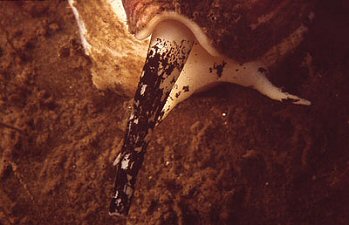
A whelk's (Buccinum undatum) siphon.
Picture: Peter Jonas, Unterwasser-Welt Ostsee.
| Part I: Basics, Herbivorous and Carrion Eating Land Snails | Part II: Carnivorous Land Snails | Part III: Sea Snails and Slugs |
 A whelk's (Buccinum undatum) siphon. Picture: Peter Jonas, Unterwasser-Welt Ostsee. |
The whelk, for example, attacks mussels pushing its foot between the mussel's shell valves before the surprised mussel can close them. Then the snail feeds on the mussel's nutritious interior. Its siphon erect , which is equipped with many sensory cells, the whelk will then continue on its journey to find more prey, which in can smell in the water it breathes.
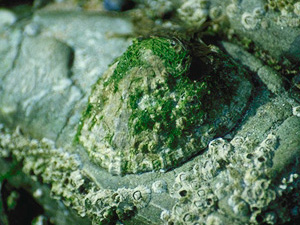
|
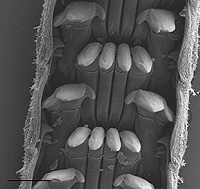
|
|
|
Left:
A limpet at its favourite resting place.
Picture: Morris, Currie, Rocky Shore Ecology. Right: Radula of the limpet Patella rustica. Picture: Courtesy of Salzburg University. |
||
Other sea snails are specialized in drilling holes in their prey's shell to feed on it afterwards. Many herbivorous sea snails therefore have developed extremely hard and resistive shells to protect themselves. Mussels try to bind attacking snails with byssus threads. Last, but not least, limpets try to hold an attacking snail's foot under their shell.
Not nearly all sea snails feed on other animals. The limpets mentioned just now specialized in grazing algae from rocks in the tidal zone. To not be washed off the rock in the surf, those snails have a cup-shaped shell and an extremely strong foot holding them so strongly on the rock surface they can hardly be removed without tools.
As an adaptation to their way of feeding, a limpet's radula is built like a rigid band. Its similarly built teeth rasp the algae off the rock's surface in a characteristic manner. As seen in the picture on the right, the limpet removes barnacles competing for the food source like a bulldozer using its shell. Where it went along during the day can be seen by a limpet's feeding trail.
Because of the abundant and diverse supply of food in the ocean and the accordingly numerous specialized methods of gastropods acquiring food, a significant number of different radula forms has developed. In gastropod systematics, the radula design is of distinct importance.
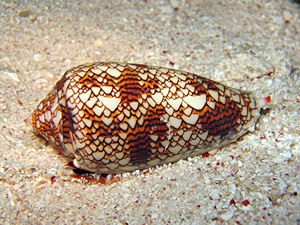 Textile cone (Conus textile). Picture R. Ling (Source) |
The rigid band type of radula used by limpets and their relatives thus is called a docoglossan (beam tongue) radula.
A completely different and also quite remarkable special case can be observed within the marine cone shells (Conidae): While the smaller species, like the Mediterranean Conus mediterraneus, hunt for polychaete worms and other molluscs, primarily snails, larger species, like Conus textile, even attack small fish.
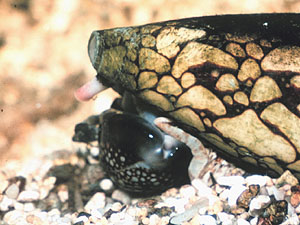 Conus marmoreus eating a cowrie shell (Cypraea caput- serpentis). Picture: James McVey. |
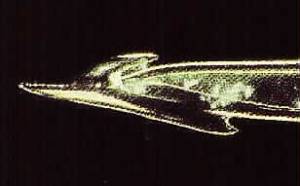 Radula tooth of a cone shell. Source: Unterwasserbilder by D. and W. Fritz. |
What is remarkable is the method cone shells hunt by: In most species of prey the animal is first immobilised with a fast-acting neural toxin and then swallowed whole. Also, a cone shell only has a small number of radula teeth left. Those are highly developed, though, and changed into a hollow injection needle, at the end of which there is a toxin gland. So the cone shell can inject its prey with toxin to keep it still and then eat it. While the smaller cone shell species', like Conus mediterraneus, toxin might only be a nuisance to humans, the larger species', like Conus textile, toxin will actually be dangerous.
Fittingly, the cone shell's radula is called a toxoglossan (venom tongue) radula.
![]() Radula types.
Radula types.
![]() Wikipedia:
Limpet.
Wikipedia:
Limpet.
![]() Wikipedia:
Cone snails.
Wikipedia:
Cone snails.
![]() Florida museum:
Cone shells.
Florida museum:
Cone shells.![]() Deep Look:
Watch These Cunning Snails Stab and Swallow Fish Whole (YouTube Video).
Deep Look:
Watch These Cunning Snails Stab and Swallow Fish Whole (YouTube Video).
![]() The Nature of
Science:
How killer cone snails kill (YouTube Video).
The Nature of
Science:
How killer cone snails kill (YouTube Video).